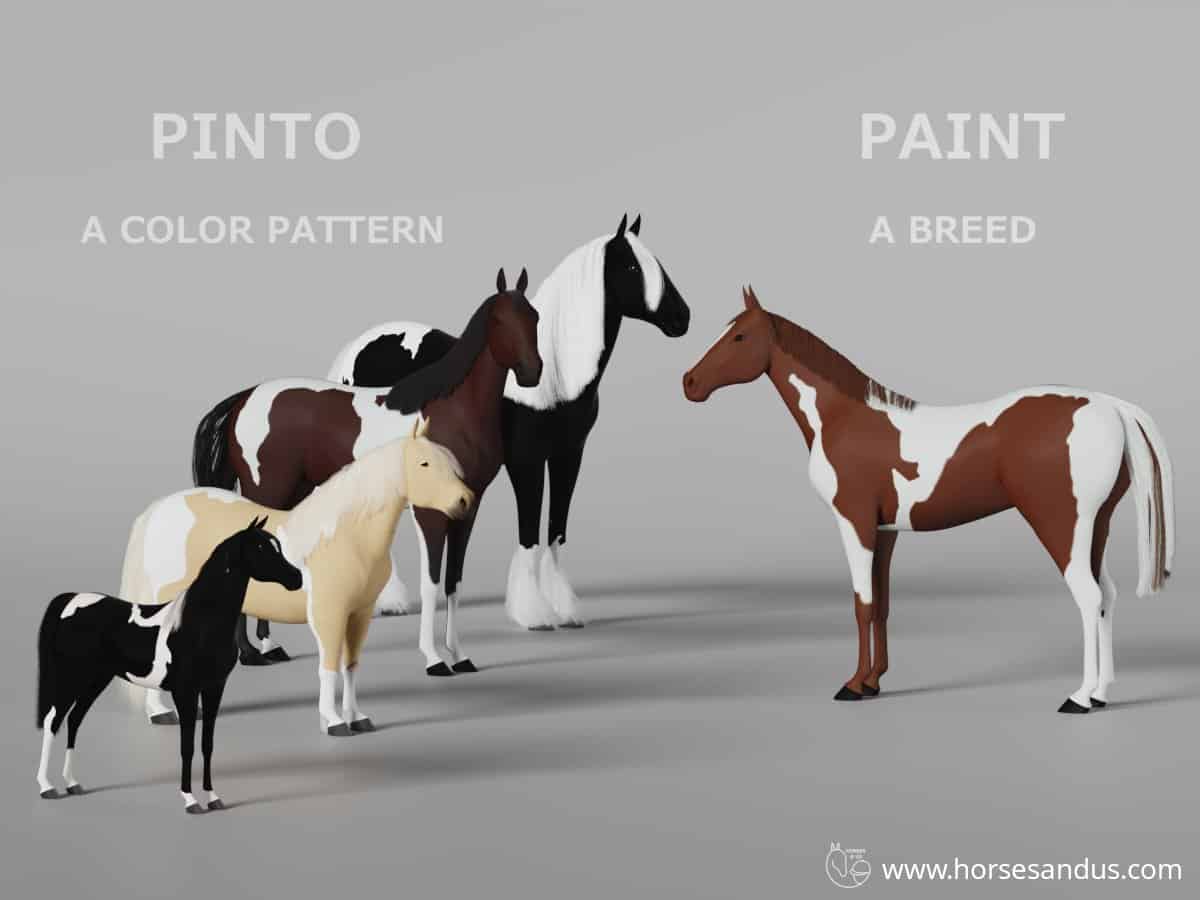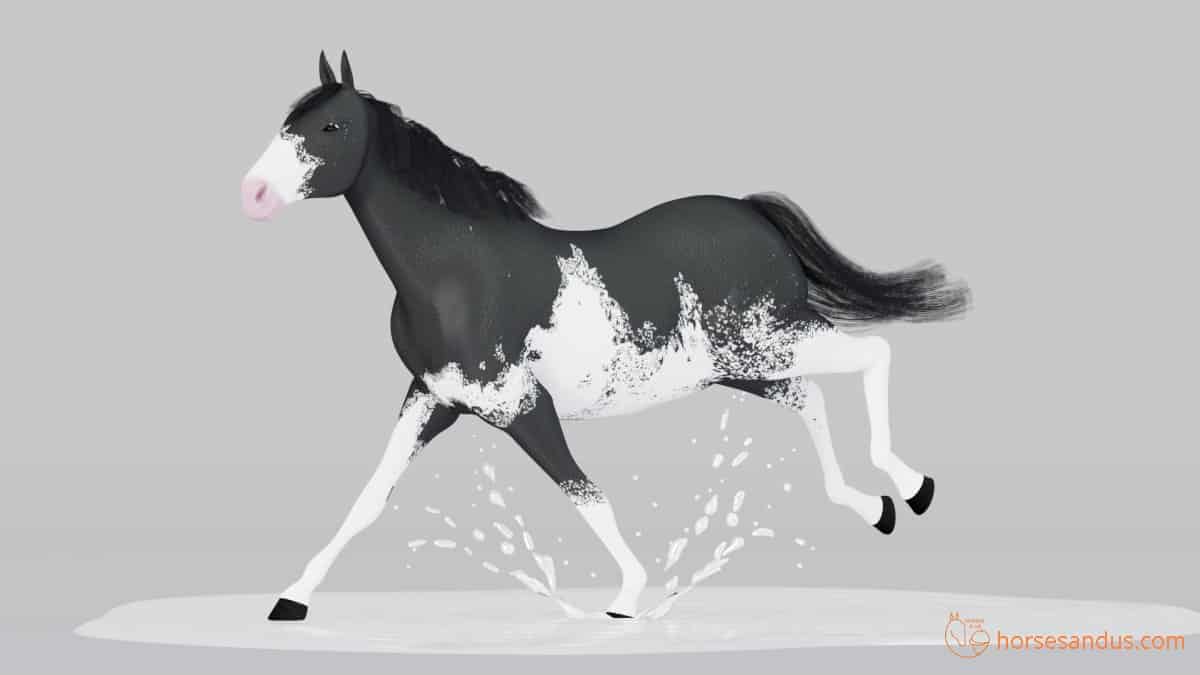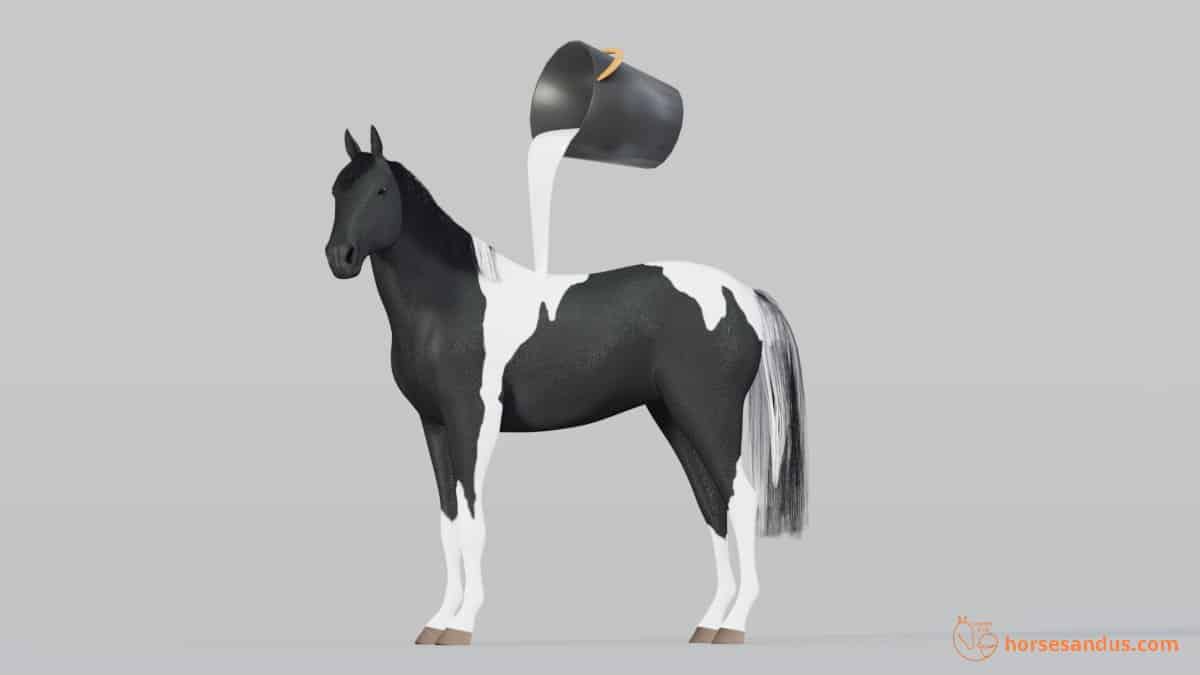You have probably already heard about Palomino, Buckskin, Cremello, or Perlino horses. But maybe you didn´t know that they all have one thing in common, which is, they are all cream colored horses.
A Cream horse has a diluted coat color produced by the Cream dilution gene. Palomino is the most well known of all the cream based coat colors.
The variation in the color of cream horses is due to:
- The base coat color (the gene affects the red pigment and can have a very subtle effect on black pigment)
- The quantity of the cream genes that are present (single dilutes and double dilutes)
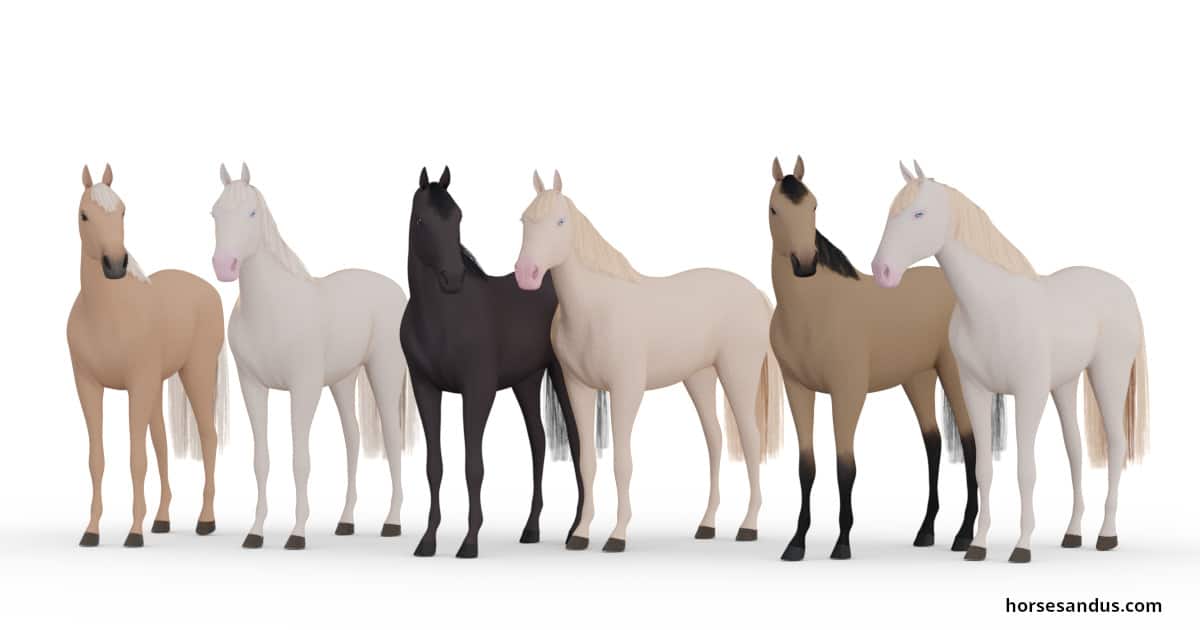
There is a huge variety of horse coat colors and patterns. In this article, we will look at the colors produced by the cream gene.
Cream gene Single Dilutes vs Double Dilutes
The Cream gene can produce several different colors and is incompletely dominant, having a dosage effect. This means it will have a different effect depending on the number of cream genes present.
- A horse with one cream gene is called a “single dilute,” which produces a dilution of the original color, making it lighter. The resulting colors are Palomino, Buckskin, and Smokey black (only one cream gene has almost no effect on black).
- A horse with two cream genes known as a “double dilute” produces an additional dilution making it even lighter and also lightening the skin and eye color. The resulting colors are Cremello, Perlino, and Smokey cream.
Cream dilution on the 3 base coat colors
The shade of a cream horse varies with the underlying base coat color and with the number of cream genes present.

Single Dilutes
When one copy of the gene occurs, it acts as a dilution gene, lightening red to gold but having almost no effect on black.
A single dilute has a minimal effect on the eye color and skin, which are dark, although may be lighter than non-diluted colors.
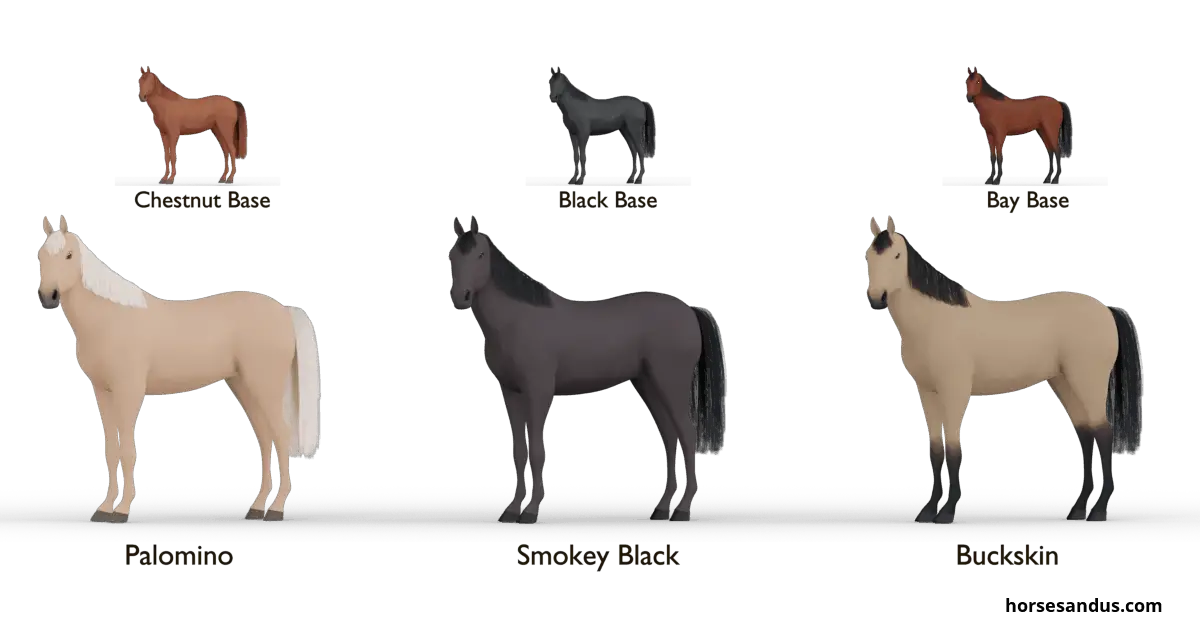
Palomino Horse (chestnut base)
Palomino horse color is the result of one cream dilution gene on a chestnut horse.
These horses have a gold coat ranging from pale cream to dark gold and a light cream or white mane and tail. Self-colored mane and tail can also occur, but this is not common.
Unless they are being affected by other genes, palominos have dark skin and brown eyes. However, some may be born with pink skin and pale blue eyes, which darken shortly after birth.
Palomino is the most well known of all the cream-based coat colors. It is a highly valued color and much sought-after, especially when the body has a golden sheen, which is very attractive.
However, breeders need to understand that it is not a true-breeding color because it is heterozygous. This means that even if both parents are palominos, the chances of having palomino offspring are only 50%. We will see this in more detail in the “cream genes inheritance” section of this article.
Smokey Black Horse (black base)
Smokey black horse color is the result of one cream dilution gene on a black horse.
Since a single copy of the cream gene has only a very subtle effect on black, smokey blacks can be quite difficult to identify.
The coat is either black or a few shades lighter than true black. It is common to have an amber eye color. The foals can be born with a silvery coat and blue eyes.
Smokey black coats tend to react strongly to sun and sweat and may be likely to fade to a brown shade under these conditions. But this is also the case of true blacks.
Due to such a subtle effect, a single cream allele has on black pigment and also the effect of weather conditions on a black coat, the smokey black is often mistaken for other colors like black, liver chestnut, grullo, and dark bay.
Buckskin (bay base)
Buckskin horse color is the result of one cream dilution gene on a bay horse.
The name buckskin refers to a color that resembles a deer; therefore, the name buck (buck is the male deer).
Like palominos, these horses have a gold coat that can range from pale cream to dark gold.
However, because a single copy of the cream gene has nearly no effect on black, the points (mane, tail, and lower legs) are almost not affected and therefore remain black or dark brown.
Buckskin foals may be of a lighter color when they are born, and the black points may not be very visible until some weeks after birth. Occasionally they are born with blue eyes.
Buckskins are sometimes mistaken for Bay Duns or Amber Champagne.
Buckskin horses are popular around the world, having appeared in several western TV shows and movies, including the 2002-animated film “Spirit.”
Double Dilutes
When two copies occur, red hairs become cream while black hairs turn to a more rusty cream. Two copies also have a strong effect on the eyes and skin. They make the eyes blue, and the skin turns rosy pink.
Both red and black pigments are strongly affected by double dilutes, but the black pigment retains a little more color and tends to have a rusty tint.
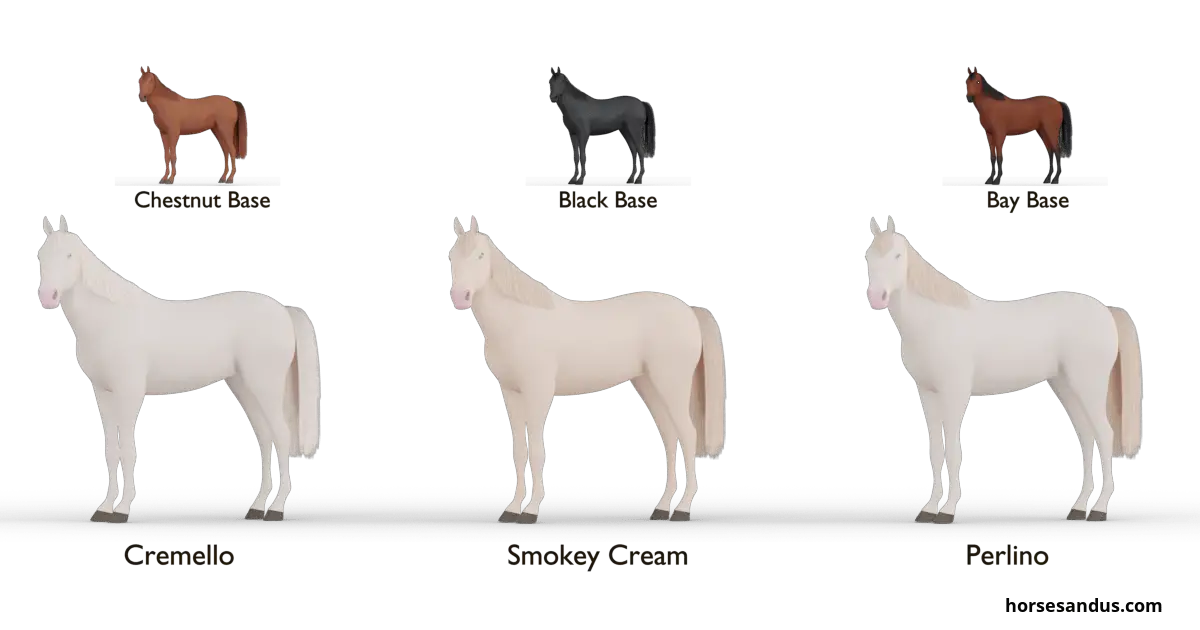
Cremello Horse (chestnut base)
Cremello horse color is the result of two cream dilution genes on a chestnut horse.
These horses have cream coats that can range from a pale off white to pale gold, and their mane and tail are white.
They have pink skin and blue eyes, which usually have problems when not protected from continuous sun exposure.
Some cremellos can be so light that they appear to be white, but if we compare them to a true white horse, we will see that cremellos are actually cream-colored.
Sometimes they are called albinos or white, but neither is correct.
Smokey Cream Horse (black base)
Smokey Cream horse color is the result of two cream dilution genes on a black horse.
These horses have very pale rusty cream coats, with pinkish skin, and blue eyes.
Their mane and tail may be coffee colored, yellowish, or smokey blue.
Perlino Horse (bay base)
Perlino horse color is the result of two cream dilution genes on a bay horse.
These horses, just like the cremellos, have cream coats that can range from a pale off-white to pale gold. However, their points (mane, tail, and lower legs) may be slightly darker with shades that range from cream, coffee-colored or pale reddish.
They have pink skin and blue eyes.
Equine Cream Gene Dosage Effect (animation)
5 Interesting facts about double dilutes
The cream gene double dilution has some interesting facts that you should know.
1. Cremello, Perlino and Smokey Cream are hard to differentiate
Cremello, Perlino, and Smokey cream horses can be difficult to distinguish from one another. They all have cream-colored coats, manes, and tails. They have blue eyes and pink skin. Even so, due to the less intense effect that the cream gene has on black hair, very subtle differences can sometimes be detected in their hair.
The black hair of the bay and black horses will have a slightly darker color than the red hairs of the bay and chestnuts. So in general:
- Cremello horses will have pale cream coats and white mane and tail.
- Perlino horses will have pale cream coats and coffee colored mane and tail
- Smokey cream horses will have rusty cream coats and coffee colored mane and tail.
But because the shade of cream in any of the three double dilutes can vary from very light to dark, it may not be possible to notice these subtle differences. Often they can only be correctly identified after genetic testing.
2. Some breeds Do not Allow registry Of Double Dilutes
In some breeds, these double dilutes are undesirable or even cannot be registered. This may be to maintain the standard breed type color. But it may also be due to concerns for health issues that unpigmented horses can have.
So, in this case, breeders need to keep away from certain matings that can produce cremellos, perlinos, or smokey creams. They need to avoid mating between two parents who can each have at least one cream dilute, like for example, mating between 2 palominos.
3. Cremello horses are not Albinos
Before the Cream gene was discovered, it was thought that the cremello horses were albinos and would not be recognized by many breed registries. However, there are no reported cases of true “albino” horses.
4. Double diluted Horses can Be Essential In Color Breeding
On the other hand, some breeds allow these colors, and in that case, a double diluted cream horse can be an essential component in a breeding program looking for single dilute creams.
For example, the cremello will contribute with a cream gene to all offspring. When mated with a non-cream horse, it will result in the desired single diluted creams, like palominos or buckskins.
5. Double diluted Horses Are Sensitive to Sun Exposure
In any case, special care should be taken with double dilute horses because they have more sensitive skin and eyes. Therefore, they are more likely to develop skin lesions and eye cysts when not protected from continuous sun exposure.
The genes behind the cream dilution

The Cream dilution is produced by the Cream gene which is represented by CR.
The absence of the cream gene is represented by cr.
As already mentioned, the cream gene is incompletely dominant, which means it has a dosage effect, and so the traits of the gene will be more pronounced when more copies of that gene are present.
The cream gene is expressed differently in its heterozygous and homozygous forms.
- The heterozygous form (single dilute – CR/cr) has a less intense effect on the red pigment and almost no effect on the black pigment.
- The homozygous form (double dilute – CR/CR) is completely expressed and affects both red and black pigments.
A single cream dilute has a 50% chance of passing cream to its offspring.
A double cream dilute has a 100% chance of passing cream to its offspring.
With this knowledge in mind, breeders can predict the outcomes of the planned matings and have more chances of producing the desired coat color for the offspring.
Cream genes inheritance
Using the following Punnett squares with a chestnut base coat color as an example, we can see some possible outcomes from different genotype combinations.

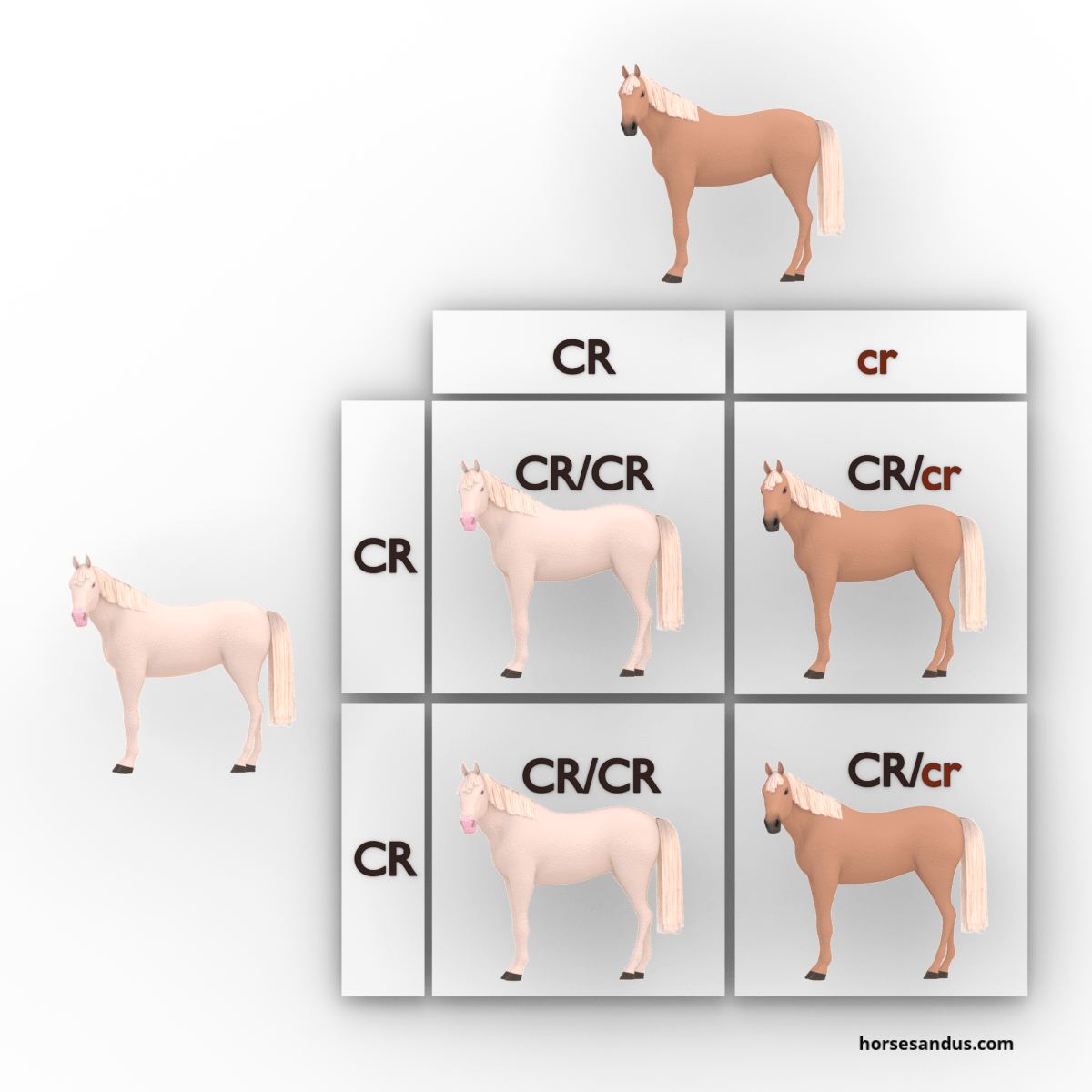
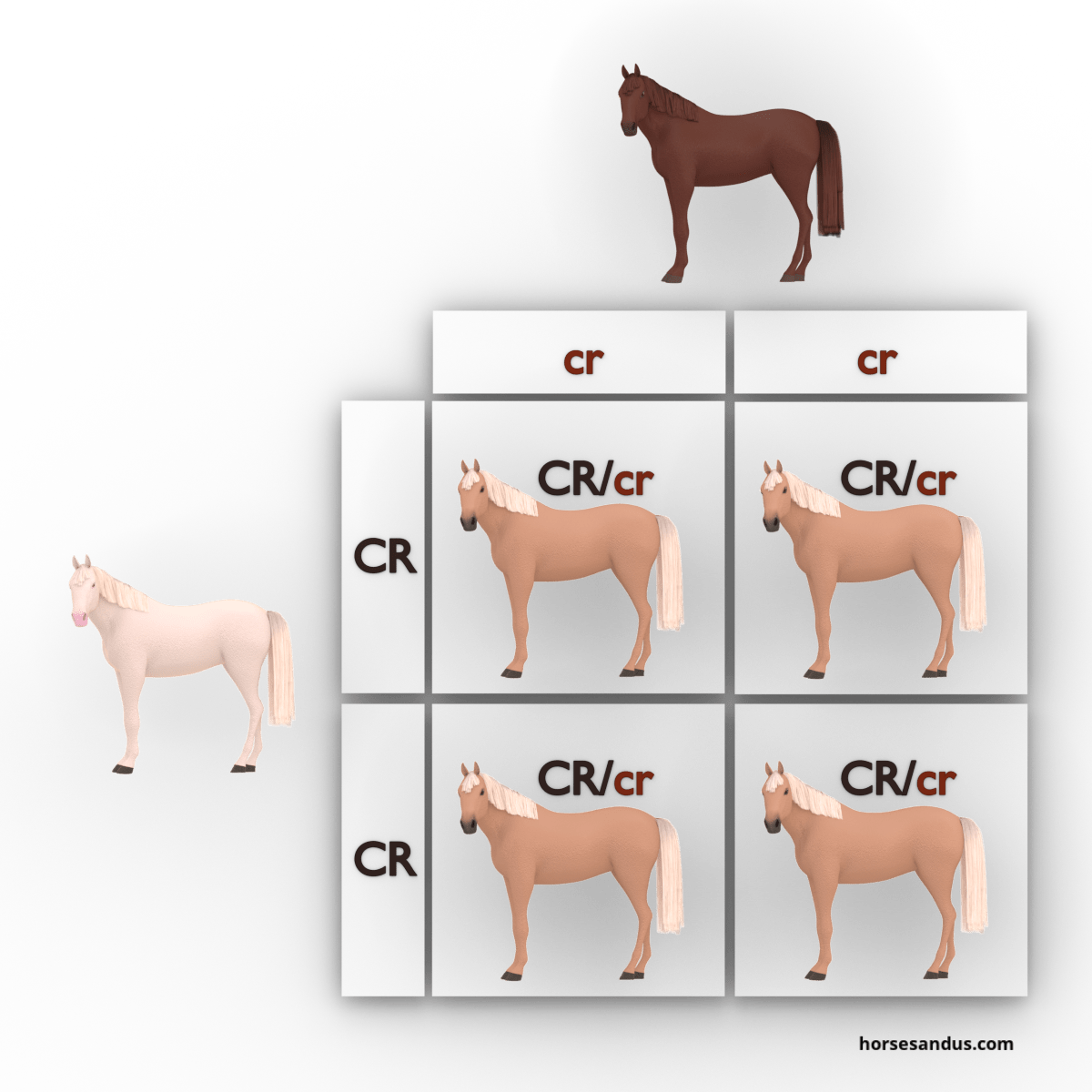
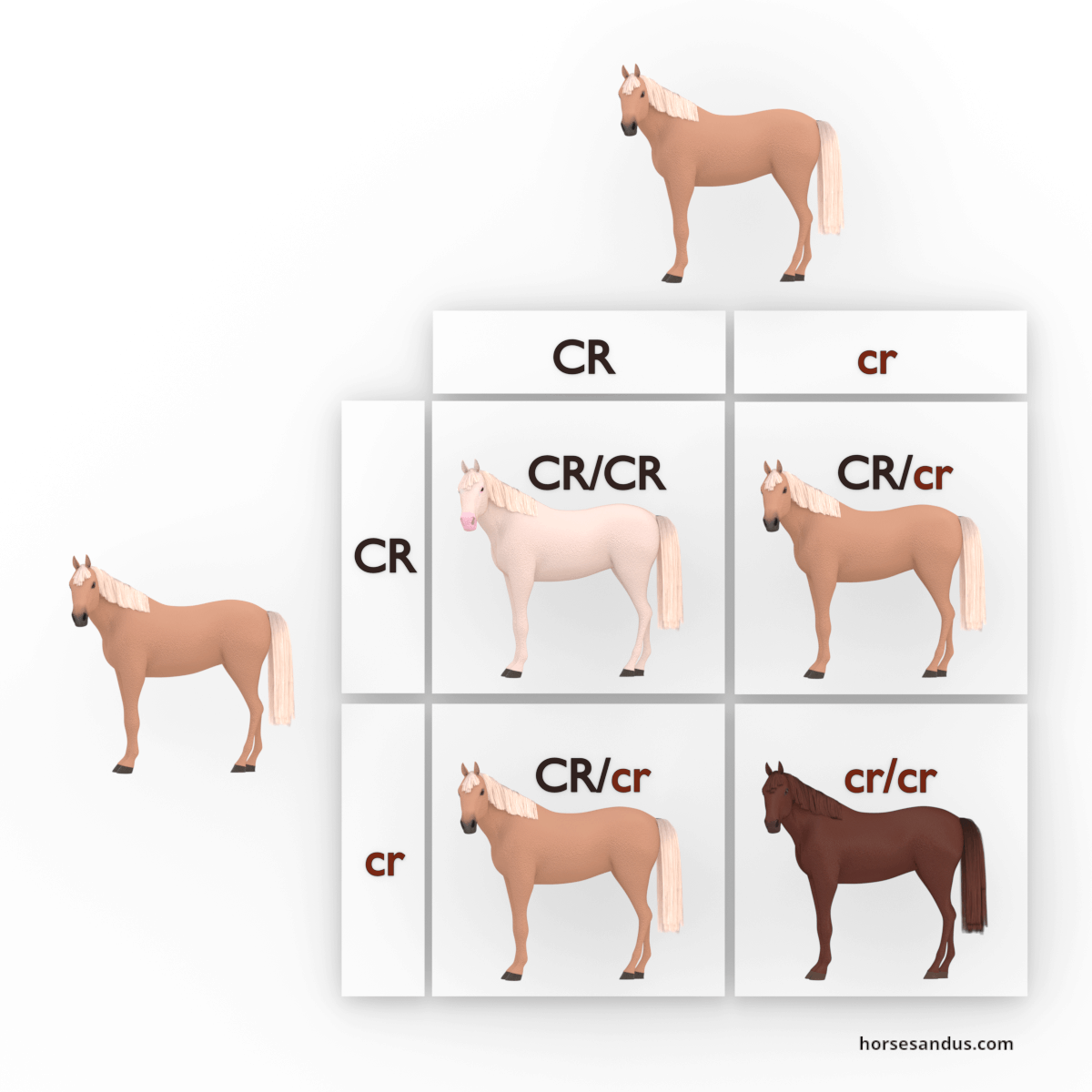
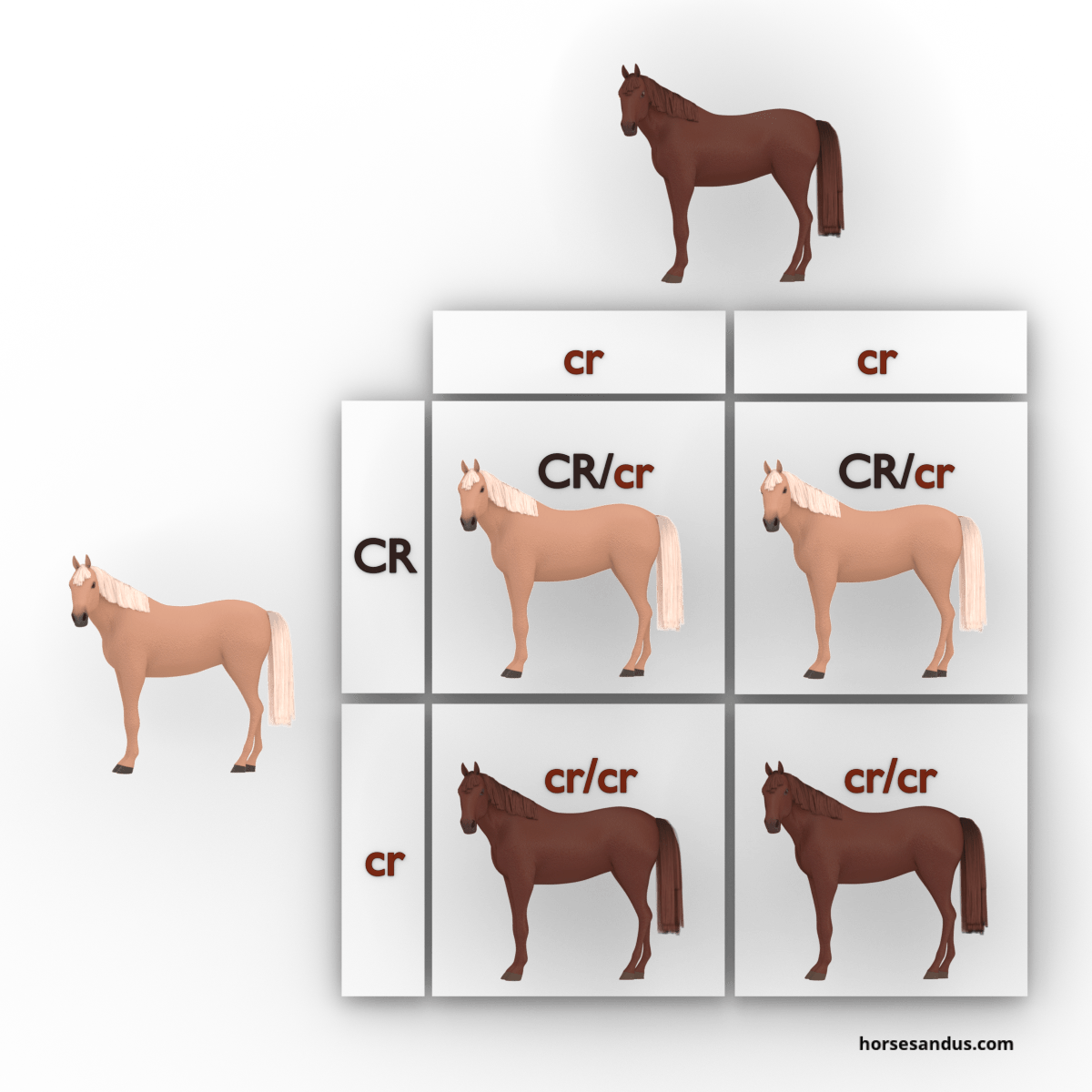
Horse breeds that can have the cream coat color?
The cream dilution is found in a wide variety of breeds.
It is common in many American breeds, like the American Quarter Horse, Morgan, American Saddlebred, Tennessee Walking Horse, and Missouri Fox Trotter.
It is also common in Iberian breeds like the Lusitano and PRE (Pura Raza Espanola).
It can also be found in the Akhal-Teke, the Miniature Horse, and the Icelandic Horse and in some ponies like the Connemara and the Welsh Pony.
It is less common in Thoroughbred and some Warmbloods.
Problems associated with the cream gene
Double dilute cream horses (Cremellos, Perlinos, and Smokey cream) with underlying unpigmented skin are affected by photosensitization due to the lack of protective pigment.
The pink skin of double dilute horses does not have melanin and, therefore, is not protected when exposed to sunlight. This leaves the skin at the mercy of UV rays and vulnerable to damage.
This is not simply a sunburn. It may cause skin lesions limited to the body’s unpigmented areas that have been exposed to sunlight. They occur mainly on the muzzle and eyelids.
These lesions present redness, swelling, and itching. Subsequent infections may occur, followed by necrosis and shedding of skin. Cancer of the skin may also develop.
You may want to try the Summer Care Butter to protect your horse´s skin from sunburn. This product can be purchased at Amazon.
The link below that leads to a product on Amazon is an affiliate link and I earn a commission (with no additional cost for you) if you make a purchase.
The Blissful Horses Summer Care Butter All Natural Sun Support for Your Horse, 4-OunceFurther Reading
If you would like to learn more about horse colors and white patterns, you may want to read the following books, available on amazon.
The links below that lead to products on Amazon are affiliate links and I earn a commission (with no additional cost for you) if you make a purchase.
The following books are an introduction to horse colors and white patterns which are full of images and very easy to understand.
The Equine Tapestry: An Introduction to Colors and Patterns The Ultimate Guide to Horse ColorsA more technical book about horse colors, but still very easy to understand.
Equine Color GeneticsSources
A mutation in the MATP gene causes the cream coat color in the horse: https://www.ncbi.nlm.nih.gov/pmc/articles/PMC2732686/pdf/1297-9686-35-1-119.pdf
